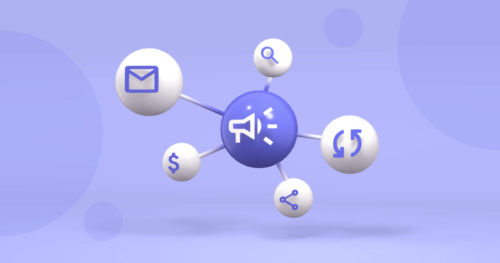With the ever-advancing pace of technological innovation that has left no sphere of life or industry untouched, it is no wonder that the current landscape of the marketing world is nigh-unrecognizable compared to only a few decades ago.
Today, the customer journey is very different from what it used to be. Shopping online has become preferable for most consumers, thus allowing the online store to overshadow traditional brick-and-mortar locations.
As a result, customer interaction now takes place across multiple channels, which is where terms such as omnichannel marketing and multichannel marketing come into play.
So, what is omnichannel marketing? What is multichannel marketing? How do they differ? What are their respective advantages and disadvantages? What are some examples of omnichannel marketing in practice? Most importantly, what do you need to keep in mind in order to develop and implement a successful omnichannel marketing strategy?
We will answer all of those questions in this article, so if you are thinking about implementing your own omnichannel marketing strategy, read on!
What Is Omnichannel Marketing?
Omnichannel (also sometimes spelled as omni-channel) marketing is a marketing approach that takes into account the various channels that a business might use to interact and communicate with its customers.
More importantly, it ties all those channels together in order to create a data-driven whole that places the customer first. This allows a business to effectively engage and retain its customers, as well as provide them with an integrated shopping experience that is completely consistent from start to finish.
What Channels Are Used In Omnichannel Marketing?
When talking about marketing channels used in an omnichannel marketing strategy, they can be divided into online and offline channels.
Online channels are comprised of all sorts of digital channels that are connected to the internet. This can include things such as a presence on social media, communication platforms, email newsletters, text bulletins, push notifications, apps installed on a desktop or mobile device, and more.
Meanwhile, offline channels cover things such as your traditional brick-and-mortar store or a customer support center. However, the fact that these channels are “offline” still doesn’t mean that they are in any way disconnected from the others. As mentioned above, they still have to be fully integrated in order to provide the customer with a seamless experience.
What Is Omnichannel Marketing Automation?
Omnichannel marketing automation refers to a variety of marketing platforms that can be used to assist businesses with the implementation of their omnichannel strategies. As the name suggests, these platforms can fully automate portions of the process, primarily when it comes to data collection and data analytics.
Additionally, such marketing platforms can also provide businesses with a wide range of useful tools that can further assist them in devising their marketing strategy.
Needless to say, without marketing automation platforms, omnichannel marketing would be much more difficult and expensive to implement efficiently. As such, they are a major factor in the landscape of modern digital marketing, and their importance cannot be overstated.
What Are Some Examples of Omnichannel Marketing?
With the definitions out of the way, you are now probably wondering what omnichannel marketing looks like in practice. So, here are some examples of successful omnichannel marketing strategies implemented by well-known businesses!
Amazon
Since its founding in the mid-1990s, Amazon has been one of the leading names associated with online shopping. And though it may have started out as an online-only store, it has adapted extremely well to the changing times and has since become one of the best examples of omnichannel marketing done right.
First and foremost, Amazon allows its customers to access their profile through a range of devices that they can seamlessly switch between without any interruption to their shopping experience. This includes their smartphone, smartwatch, desktop or laptop PC, and even Amazon Alexa devices.
Furthermore, in addition to offering a streamlined user experience, Amazon is known for making efficient use of customer data in order to deliver targeted ads and discounts at opportune times, thus increasing customer engagement and its ROI.
Starbucks
Another great example of omnichannel marketing that contributes significantly to customer satisfaction can be seen in one of the strategies used by Starbucks. With the increased focus on their mobile app, the company has made online transactions incredibly convenient for the customer, thus speeding up the process and minimizing wait time in stores.
Moreover, while Starbucks is by no means the first business to implement a customer loyalty program, it has done an exceptional job of streamlining the experience by allowing the user to reload their Starbucks Rewards card instantly and easily, be it via their app or a browser.
Additionally, Starbucks also relies heavily on delivering targeted ads and timed discounts based on their customers’ behavior, taking into account their preferred products and the time of day that they are most likely to purchase them.
Spotify
Finally, yet another noteworthy example of an excellent omnichannel experience comes from none other than one of the leading music streaming services in the world, Spotify. This particular case is a perfect example of how an omnichannel approach can be implemented in a business where customer retention is a top priority.
Namely, Spotify is known for its song and artist recommendations based on the user’s listening habits. In between recommended songs at the end of each playlist and the automatically-generated Radio playlists, Spotify’s algorithms provide an amazing means to help the user discover new music and thus motivate them to continue using the service.
Furthermore, Spotify allows the user to seamlessly switch between a number of supported devices, even if it is mid-song. All the user has to do is select a different device from within the app, and the music will continue to play uninterrupted on the new device.
What Is Multichannel Marketing?
Multichannel (also sometimes spelled as multi-channel) marketing is another type of marketing strategy that places the business and the brand identity first, rather than the customer. It utilizes a high number of channels in order to reach out to a high number of customers and get the business’s message across.
With that in mind, multichannel marketing is fundamentally different from omnichannel marketing, despite the apparent similarity that the name might imply.
Since the strategy is not centered around the individual customer, it does not offer a data-driven, personalized customer journey. On top of that, it does not tie all of its channels together and thus cannot provide the individual with a consistent message and a consistent experience across all channels.
As such, multichannel marketing is more akin to the previously mentioned “widest net possible” approach to marketing. It prioritizes quantity over quality and tries to reach out to as many customers as possible in order to try and increase conversion rates.
Ultimately, multichannel marketing is not as effective as omnichannel marketing is in practice, but it is still a viable strategy for businesses that do not have the resources or the customer data required to implement a successful omnichannel strategy.
The Advantages of Omnichannel Marketing
There are a number of reasons why omnichannel marketing has become so popular over the recent years, most of it having to do with advances in technology.
Omnichannel marketing automation tools are more sophisticated than ever, and customer data is more readily available. Add to this the proven effectiveness of omnichannel marketing strategies, and it is no wonder that it has become as popular as it has with businesses around the globe.
In fact, the vast majority of US-based businesses have implemented omnichannel marketing, even if only partially. Moreover, recent statistics also show that almost 70% of eCommerce decision-makers in North America and Europe assign high importance to omnichannel marketing strategies.
But How Exactly Does Omnichannel Marketing Help Your Business?
In essence, the customer-oriented approach that defines omnichannel marketing is what opens the door for all of the benefits associated with it.
By placing the customer first and granting you insights into their preferences and behavior, omnichannel marketing can help you achieve significantly higher engagement and conversion rates compared to single-channel or multichannel marketing. Having multiple marketing channels means that your message will reach more people, and data allows you to tailor that message in order to make it resonate more strongly with the individual.
On top of that, the personalized experience that omnichannel marketing offers can greatly help with building brand loyalty and improving long-term customer retention. Satisfied customers that keep coming back to your business will not only spend more over time, but they are also likely to direct more customers to you.
With the above in mind, it’s clear that any business that wishes to optimize its marketing strategy and maximize its ROI should definitely strive to tie all of its marketing channels into a comprehensive omnichannel system, provided that it has the means to do so.
How To Develop An Omnichannel Marketing Strategy
Now that we have gone over what omnichannel marketing is and what its general benefits are, we come to the next important question: how do you implement an omnichannel marketing strategy for your business?
There are several key aspects to consider here, and we will go over each of them below.
The Customer Journey
As we have previously established, omnichannel marketing means placing the customer first. That said, it is impossible to provide a customer with a satisfying experience without putting yourself in their shoes and experiencing the customer journey first-hand.
This first step may seem relatively simple, but it is vital to developing the customer experience as a whole. It lets you see what your customer sees and thus lets you streamline the experience across all channels and all touchpoints.
Do all of the channels you are using get your message across clearly? Do they integrate seamlessly with each other? How responsive and efficient is your customer support? These are some of the key questions that need to be answered at this stage before you can iron out any issues and set the foundation for your business’s omnichannel strategy.
Know Your Customer
Seeing things from your customer’s perspective is step one, but actually knowing your customer is even more important if you wish to reach your target audience. Since omnichannel marketing is data-driven and hinges on a personalized customer experience, collecting and analyzing data is a crucial part of the process.
This mainly includes data about individual customers that would allow you to properly personalize their experience. Moreover, it also includes general information that can be used to segment your customer base using various criteria, which can then help you optimize your marketing strategy as a whole.
Though data collection and data analytics may seem intimidating at first, marketing tools such as Verfacto can make the process surprisingly easy by providing you with the right set of specialized tools to collect data relevant for your omnichannel campaign.
Personalize Across Multiple Channels
Once you have the relevant data, the next step is to put it to proper use. That is to say, to provide that all-important personalized customer experience via behavioral targeting across all the channels you are using.
Behavioral targeting is the process of analyzing the collected data that will allow you to deliver targeted ads and offers at just the right time based on each individual customer’s behavior. Since it tailors the experience to the individual, behavioral targeting can noticeably increase conversion rates and improve customer engagement, thus increasing your ROI.
Some of the relevant data that is used in behavioral targeting includes which pages the customer visits, how much time they spend viewing each page on average, what channels they prefer using, what types of content they respond to best, their shopping history, and more.
At first glance, behavioral targeting may seem quite complicated, much like the process of data collection itself. However, it is remarkably easy to utilize with the help of specialized omnichannel marketing automation tools such as Verfacto that automatically compile and deliver all of the important data that drives behavioral targeting.
Segment Your Customer Base
Each customer is unique, but they can still be grouped into different categories based on a variety of factors. So, while a personalized customer experience is the cornerstone of omnichannel marketing, segmenting your customer base according to key characteristics is crucial for the further development and optimization of your overall omnichannel marketing strategy.
Much like behavioral targeting is used for the purposes of personalization on an individual level, so can behavioral segmentation be used for efficient and accurate customer segmentation. The way it functions is quite similar, as it revolves around analyzing relevant data that can be used to categorize your customers according to a variety of criteria.
These criteria commonly cover basic information such as gender, age, location, education, or marital status. Additionally, they can also include more specific factors regarding the customer’s purchasing behavior, whether they primarily use a desktop or a mobile device, and more. Meanwhile, when it comes to B2B marketing, it can include factors such as company size, the industry they operate in, their annual turnover, etc.
Customer segmentation is yet another step that has the potential to be quite complicated and time-consuming. But much like with the previous two steps, this is also where you can greatly benefit from using a marketing automation tool such as Verfacto. As you might expect, it can handle the segmentation process and provide you with comprehensive, up-to-date information without placing needless strain on your marketing team.
Ultimately, a properly segmented customer base will allow you to optimize your resource allocation and make your marketing efforts as effective and as cost-efficient as possible.
Keep A Close Eye On Your Metrics
Just because your omnichannel marketing strategy might not appear too fruitful initially doesn’t mean it cannot be improved. Just the same, even if it performs remarkably well from the get-go, that doesn’t mean it cannot get even better.
This is where eCommerce metrics come in, providing valuable information as to the performance of your marketing campaign.
It’s one of the more complex parts of any digital marketing journey, as there is a wide range of metrics to keep in mind. In short, they include:
- Email and social media metrics — Are you getting your message across effectively? Is it being heard? Is it engaging your existing and potential customers successfully?
- Customer acquisition metrics — Are potential customers responding to your messaging? How much does acquiring new customers cost you on average?
- Customer conversion metrics — How effectively do you convert visitors into customers?
- Customer retention and value metrics — How effective are you at retaining existing customers?
- Customer satisfaction metrics — Are existing customers satisfied with your service? How likely are they to earn you new ones by promoting your service?
You can find more in-depth information on the subject of marketing metrics here.
Customer retention, in particular, is generally deemed to be highly important, as retaining existing customers is far less expensive than acquiring new ones. This is why metrics such as Customer Lifetime Value (or “LTV” for short) are so important.
This metric takes into account the total value of a customer from their very first purchase to the most recent one, hence the term “lifetime.”
As we have mentioned previously, not only are long-term customers more likely to spend more over time, but they are also more likely to promote your brand. As a result, they can reduce the costs of customer acquisition and thus lead to an overall increase in revenue. That said, it is easy to see why customer loyalty is so important.
Fortunately, Customer Lifetime Value data is easy enough to take advantage of with services such as Verfacto that can automatically predict a customer’s LTV based on their behavior, allowing you to more accurately project your earnings and determine the best marketing approach on an individual basis—all with the help of some clever omnichannel marketing automation!
Closing Thoughts
It is clear that omnichannel marketing is here to stay, and its popularity alone speaks volumes as to its effectiveness. Though it might seem intimidating at first, especially for a small business, successfully implementing an omnichannel approach in your marketing efforts stands to more than pay off in the long run.
If you are thinking about implementing omnichannel marketing in the future or are looking to try and improve an existing strategy, then Verfacto would be a good tool to help in either case. As mentioned in the article, it is an extremely useful omnichannel automation tool and offers a variety of indispensable features that are bound to make your marketing journey easier.
Click here for a 1-month free trial to give it a try!



